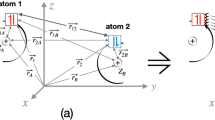Abstract
In 2005, Surján showed two explicit formulas for evaluating the second-order Møller–Plesset perturbation (MP2) energy as a functional of the Hartree–Fock density matrix \(\varvec{D}\) (Chem Phys Lett 406:318, 2005), which are referred to as the \(\Delta E_\text {MP2}[\varvec{D}]\) functionals. In this paper, we present the finite-temperature (FT) MP2 energy functionals of the FT Hartree–Fock density matrix. There are also two formulas for the FT-MP2, namely the conventional and renormalized ones; the latter of which has recently been formulated by Hirata and He (J Chem Phys 138:204112, 2013). We proved that there exists one-to-one correspondence between the formulas of two FT-MP2 and the \(\Delta E_\text {MP2}[\varvec{D}]\) functionals. This fact can explain the different behavior of two \(\Delta E_\text {MP2}[\varvec{D}]\) functionals when an approximate Hartree–Fock density matrix is applied, which was previously investigated by Kobayashi and Nakai (Chem Phys Lett 420:250, 2006). We also applied the FT-MP2 formalisms to the linear-scaling divide-and-conquer method for improving the accuracy with tiny addition of the computational efforts.





Similar content being viewed by others
References
Helgaker T, Jørgensen P, Olsen J (2002) Molecular electronic-structure theory. Wiley, Chichester
Rolik Z, Szabados Á, Surján PR (2003) J Chem Phys 119:1922
Szabados Á, Rolik Z, Tóth G, Surján PR (2005) J Chem Phys 122:114104
Surján P, Rolik Z, Szabados Á, Kőhalmi D (2004) Ann Phys 13:223
Kobayashi M, Szabados Á, Nakai H, Surján PR (2010) J Chem Theory Comput 6:2024
Szabados Á, Nagy P (2011) J Phys Chem A 115:523
Surján PR (1999) An introduction to the theory of geminals. In: Surján PR (ed) Correlation and localization. Springer, Berlin, pp 63–88
Jeszenszki P, Nagy PR, Zoboki T, Szabados Á, Surján PR (2014) Int J Quantum Chem 114:1048
Tarumi M, Kobayashi M, Nakai H (2012) J Chem Theory Comput 8:4330
Møller C, Plesset MS (1934) Phys Rev 46:618
Shavitt I, Bartlett RJ (2009) Many-body methods in chemistry and physics: MBPT and coupled-cluster theory. Cambridge University Press, Cambridge
Tsuneda T (2014) Density functional theory in quantum chemistry. Springer, Tokyo
Engel E, Dreizler RM (2011) Density functional theory: an advanced course. Springer, Heidelberg
Surján PR (2005) Chem Phys Lett 406:318
Almlöf J (1991) Chem Phys Lett 181:319
Häser M (1993) Theor Chim Acta 87:147
Ayala PY, Scuseria GE (1999) J Chem Phys 110:3660
Kobayashi M, Nakai H (2006) Chem Phys Lett 420:250
Surján PR, Szabados Á (2011) Perturbative approximations to avoid matrix diagonalization. In: Papadopoulos MG, Zalesny R, Mezey PG, Leszczynski J (eds) Linear-scaling techniques in computational chemistry and physics: methods and applications. Springer, Dordrecht, pp 83–95
Kobayashi M, Nakai H (2011) Divide-and-conquer approaches to quantum chemistry: theory and implementation. In: Papadopoulos MG, Zalesny R, Mezey PG, Leszczynski J (eds) Linear-scaling techniques in computational chemistry and physics: methods and applications. Springer, Dordrecht, pp 97–127
Kobayashi M, Nakai H (2012) Phys Chem Chem Phys 14:7629
Akama T, Kobayashi M, Nakai H (2007) J Comput Chem 28:2003
Yang W (1991) Phys Rev Lett 66:1438
Yang W, Lee TS (1995) J Chem Phys 103:5674
Kobayashi M, Akama T, Nakai H (2006) J Chem Phys 125:204106
Kobayashi M, Imamura Y, Nakai H (2007) J Chem Phys 127:074103
Kobayashi M, Nakai H (2008) J Chem Phys 129:044103
Kobayashi M, Nakai H (2009) J Chem Phys 131:114108
Yoshikawa T, Kobayashi M, Nakai H (2013) Int J Quantum Chem 113:218
Bloch C (1965) Diagram expansions in quantum statistical mechanics. In: de Boer J, Uhlenbeck GE (eds) Studies in statistical mechanics, vol 3. North-Holland, Amsterdam, pp 3–211
Blaizot JP, Ripka G (1985) Quantum theory of finite systems. The MIT Press, Cambridge
Hirata S, He X (2013) J Chem Phys 138:204112
Kohn W, Luttinger JM (1960) Phys Rev 118:41
Matsubara T (1955) Prog Theor Phys 14:351
Thouless DJ (1957) Phys Rev 107:1162
Cremer D (2011) WIREs Comput Mol Sci 1:509
Lipparini E (2008) Modern many-particle physics, 2nd edn. World Scientific, Singapore
Thouless DJ (1972) The quantum mechanics of many-body systems, 2nd edn. Academic Press, New York
Cohen AJ, Mori-Sánchez P, Yang W (2009) J Chem Theory Comput 5:786
Mattuck RD (1976) A guide to Feynman diagrams in the many-body problem. McGraw-Hill, New York
Yoshikawa T, Kobayashi M, Nakai H (2011) Theor Chem Acc 130:411
Yoshikawa T, Nakai H (2015) Theor Chem Acc 134:53
Mezey PG (1995) J Math Chem 18:141
Szekeres Z, Mezey PG, Surján PR (2006) Chem Phys Lett 424:420
Nakai H (2002) Chem Phys Lett 363:73
Kobayashi M, Nakai H (2009) Int J Quantum Chem 109:2227
Kobayashi M, Nakai H (2013) J Chem Phys 138:044102
Schmidt MW, Baldridge KK, Boatz JA, Elbert ST, Gordon MS, Jensen JH, Koseki S, Matsunaga N, Nguyen KA, Su S, Windus TL, Dupuis M, Montgomery JA Jr (1993) J Comput Chem 14:1347
Gordon MS, Schmidt MW (2005) Advances in electronic structure theory: gamess a decade later. In: Dykstra CE, Frenking G, Kim KS, Scuseria GE (eds) Theory and applications of computational chemistry: the first forty years. Elsevier, Amsterdam, pp 1167–1189
Hariharan PC, Pople JA (1973) Theor Chim Acta 28:213
Sidje RB (1998) ACM Trans Math Software 24:130
Akama T, Kobayashi M, Nakai H (2009) Int J Quantum Chem 109:2706
Hehre WJ, Ditchfield R, Pople JA (1972) J Chem Phys 56:2257
Acknowledgments
The authors are grateful to Prof. Hiromi Nakai and Dr. Takeshi Yoshikawa (Waseda University) for their valuable comments. Some of the present calculations were performed using the computer facilities at Research Center for Computational Science, Okazaki, and at Research Institute for Information Technology, Kyushu University, Japan. This work was supported in part by JSPS KAKENHI Grant No. 25810011.
Author information
Authors and Affiliations
Corresponding author
Additional information
Published as part of the special collection of articles “Festschrift in honour of P. R. Surjan”.
Rights and permissions
About this article
Cite this article
Kobayashi, M., Taketsugu, T. Second-order Møller–Plesset perturbation (MP2) theory at finite temperature: relation with Surján’s density matrix MP2 and its application to linear-scaling divide-and-conquer method. Theor Chem Acc 134, 107 (2015). https://doi.org/10.1007/s00214-015-1710-y
Received:
Accepted:
Published:
DOI: https://doi.org/10.1007/s00214-015-1710-y




